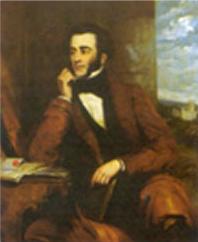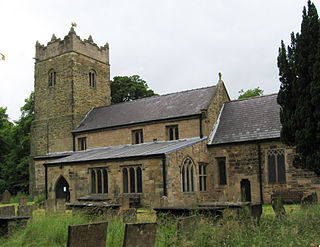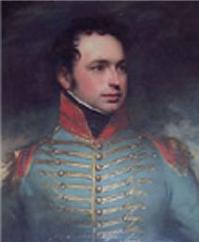
George Edward Stanhope Molyneux Herbert, 5th Earl of Carnarvon, DL, styled Lord Porchester until 1890, was an English peer and aristocrat best known as the financial backer of the search for and the excavation of Tutankhamun's tomb in the Valley of the Kings.

Henry Howard Molyneux Herbert, 4th Earl of Carnarvon,, known as Lord Porchester from 1833 to 1849, was a British politician and a leading member of the Conservative Party. He was twice Secretary of State for the Colonies and also served as Lord Lieutenant of Ireland.

Henry George Alfred Marius Victor Francis Herbert, 6th Earl of Carnarvon was a British peer. He was the son of George Herbert, 5th Earl of Carnarvon and Almina Wombwell, whose biological father was banker Alfred de Rothschild.

Sutton-in-Ashfield is a market town in the Ashfield district of Nottinghamshire, England, with a population of around 49,023, it is the largest town in the district of Ashfield. It is situated four miles west of Mansfield, two miles from the Derbyshire border and twelve miles north of Nottingham. There are villages which make up Sutton in Ashfield these are Teversal, Skegby, Stanton Hill and Huthwaite.

Colonel The Honourable Aubrey Nigel Henry Molyneux Herbert, of Pixton Park in Somerset and of Teversal, in Nottinghamshire, was a British soldier, diplomat, traveller, and intelligence officer associated with Albanian independence. He was twice offered the throne of Albania. From 1911 until his death he was a Conservative Member of Parliament. His eldest half-brother was George Herbert, 5th Earl of Carnarvon (1866–1923), the Egyptologist who famously discovered the tomb of Tutankhamun, who predeceased him by five months, by legend due to the "curse of the pharaohs". He suffered during most of his life from poor eyesight and was almost blind by his early 40s.

Henry John George Herbert, 3rd Earl of Carnarvon, FRS, styled Lord Porchester from 1811 to 1833, was a British writer, traveller, nobleman, and politician.
George Reginald Oliver Molyneux Herbert, 8th Earl of Carnarvon, styled Lord Porchester from 1987 to 2001, is a British peer and arable farmer.

Teversal is a small village in the Ashfield district of Nottinghamshire, England, located 3 miles west of Mansfield, close to the Derbyshire border. It is in the town of Sutton-in-Ashfield. Former names include Tevershalt, Teversholt, Tyversholtee, Teversale, Tevershall and Teversall.

Colonel Henry George Herbert, 2nd Earl of Carnarvon DL, FSA, styled The Honourable Henry Herbert from 1780 to 1793 and Lord Porchester from 1793 to 1811, was a British peer, nobleman, and Whig politician.

There have been three baronetcies created for descendants of the ancient Norman family of Molyneux who were granted extensive estates in Lancashire after the Norman Conquest.
The Molineux Hotel in Wolverhampton is an 18th-century former mansion house known as Molineux House, which later served as a hotel and currently, following restoration serves as a local authority facility. It is a Grade II* listed building.

The St Katherine's Church is on Buttery Lane, Teversal, Nottinghamshire, England. It is an active Church of England parish church in the deanery of Newstead, the Archdeaconry of Newark, and the Southwell and Nottingham diocese. Its benefice has three churches, St Andrew's Church, Skegby, All Saints' Church, Stanton Hill and St Katherine's itself. The church is recorded in the National Heritage List for England as a designated Grade I listed building.

Pixton Park is a country house in the parish of Dulverton, Somerset, England. It is associated with at least three historically significant families, successively by descent: Acland, amongst the largest landowners in the Westcountry; Herbert, politicians and diplomats; and Waugh, writers. The present grade II* listed Georgian mansion house was built circa 1760 by the Acland family and in 1870 was altered by Henry Herbert, 4th Earl of Carnarvon (1831–1890). Although Pixton Park is situated within the manor of Dulverton, the manorial chapel relating to Pixton is situated not at Dulverton but within the Church of St Nicholas, Brushford, across the River Barle, as the lordship of the manor of Dulverton was held from 1568 by the Sydenham family seated at Combe House, on the opposite side of the River Barle to Dulverton and Pixton.
Lord Henry Thomas Howard-Molyneux-Howard, known as Henry Howard until 1812, and as Henry Molyneux-Howard until 1817, was a British gentleman who served as Deputy Earl Marshal in the latter part of the reign of George III and early in the reign of George IV. On the inheritance of the Dukedom of Norfolk in 1815 by his elder brother Bernard, Henry Molyneux-Howard in 1817 was granted the courtesy title "Lord", the style of a younger son of a duke.
Henry Howard was a British Member of Parliament.
Sir Francis Molyneux, 7th Baronet (1738–1812) was a courtier who became Gentleman Usher of the Black Rod.

Almina Herbert, Countess of Carnarvon, was the wife of George Herbert, 5th Earl of Carnarvon, and châtelaine of Highclere Castle in Hampshire. After her second marriage, she was known as Almina Dennistoun.

Tetton is an historic estate in the parish of Kingston St Mary in the English county of Somerset. The present grade II* listed Tetton House dates from 1790 and was enlarged and mainly rebuilt in 1924-6 by Hon. Mervyn Herbert (1882-1929) to the design of the architect Harry Stuart Goodhart-Rendel.
Sir John Molyneux of Teversal, High Sheriff of Nottinghamshire.
Sir James Harington, 1st Baronet of Ridlington, Rutland was an English politician.














